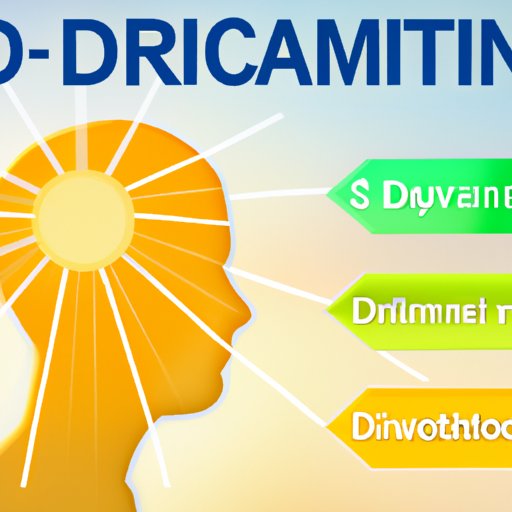
Introduction
Headaches are a common ailment experienced by many people, but did you know that low vitamin D levels can contribute to them? In this article, we will explore the connection between vitamin D and headaches, including the physiology behind it, research findings, diagnosis and treatment options, how to increase vitamin D intake, and sun exposure’s role in this.
The Importance of Vitamin D for Headache Prevention: How Low Levels Can Cause Discomfort
Vitamin D is an essential vitamin that plays a vital role in overall health. It helps maintain bone health, regulates cell growth, and supports immune function. Additionally, it helps reduce inflammation, which can contribute to headaches.
When vitamin D levels are low, it can cause discomfort in the form of headaches. Vitamin D deficiency is widespread, with studies showing that up to 50% of the population may not have adequate levels. Those at a higher risk of deficiency include people with limited sun exposure, darker skin tones, as well as those with obesity and gut issues that can interfere with absorption.

The Physiology Behind Headaches Caused by Low Vitamin D Levels
The correlation between vitamin D and headaches can be attributed to several physiological processes. Vitamin D affects the levels of neurotransmitters such as dopamine and serotonin, which contribute to pain modulation and mood regulation. When levels are low, it may trigger headaches.
Additionally, vitamin D helps reduce inflammation within the body, including the brain. Inflammation can cause pain and increase the risk of headaches. Low vitamin D levels have also been linked to hypertension, another potential cause of headaches.
Discovering the Link Between Low Vitamin D Levels and Headaches: Research Findings
Several studies have been conducted on the link between vitamin D and headaches. A 2017 study published in the Journal of Headache Pain found that people who had vitamin D deficiency complaints had more frequent and severe headaches than those with sufficient levels. Another study published in Nutrients in 2018 found that vitamin D supplementation could help alleviate the frequency and duration of migraines compared to a placebo group.
Vitamin D Deficiency and Headaches: Diagnosis and Treatment Options
Symptoms of vitamin D deficiency can be challenging to identify as they can be mild and misinterpreted as stress, depression, or other medical conditions. A blood test is crucial in determining if you have low levels and the severity of the deficiency.
There are conventional treatment options for headaches caused by low vitamin D levels, including vitamin D supplementation. A primary care physician or specialist can guide you regarding the appropriate dose based on your test results.
How to Increase Vitamin D Intake to Alleviate Headaches
Increasing your vitamin D intake can be done by either optimizing sun exposure or obtaining it from dietary sources and supplements. Some dietary sources of vitamin D include fatty fish, mushrooms, dairy, and egg yolks.
However, it can be challenging to obtain enough vitamin D from food alone, especially if you have certain dietary restrictions or intolerances. Vitamin D supplementation is an efficient way to help increase vitamin D levels. It is essential to consult with a healthcare professional to determine the appropriate dose.
The Connection Between Low Levels of Sun Exposure and Headaches Due to Vitamin D Deficiency
Sun exposure is a significant source of vitamin D production within the body. Sun exposure in the morning is the best time to maximize vitamin D synthesis, about 10-15 minutes a day, as too much sun exposure can be harmful.
However, people who live in locations with limited sun exposure or who are unable to go outside due to working and studying environments might be at risk of vitamin D deficiency. That can lead to headaches. Ensuring adequate vitamin D levels by optimizing sun exposure or taking supplements can help alleviate symptoms and prevent them from arising in the future.
Conclusion
In summary, low levels of vitamin D have been linked to headaches through various physiological pathways. It’s important to recognize the signs of vitamin D deficiency and take proactive steps to treat it. You can do so by having an adequate amount of sun exposure, partaking in vitamin D-rich food sources, or taking supplements. By doing this, you can help reduce the frequency and severity of headaches and improve overall health outcomes.




